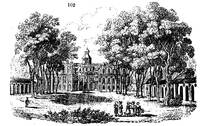354. Favorite, between Ettlingen and Rastadt, was a residence of Sybilline Augusta, wife to Louis, last prince of Baden. It was built about 1780, at a great expense, from the design of a French architect. The situation is flat, and tho views towards the Rhine are tame and monotonous; but those towards the Black Forest are very fine. The grounds were laid out in the natural manner by Anslie, before he became gardener to the Sultan at Constantinople; and, though tame and without much character, are nevertheless verdant and pleasing. They contain some large spruce firs, catalpas, American oaks, walnuts, acacias, camellias, poplars clothed with mistletoe, and weeping willows. The house (fig. 102.) consists of a centre, and two long extended detached wings. One of these wings, about 150 feet in length, and one story high, is nothing more than a roofed arcade, open on all sides, apparently for the purpose of walking in during rainy or very hot weather. The effect of this wing is simple and grand; for though, as may be seen by the view, it is nothing more than a long, low building, with a commonplace roof, yet the open arcade, and the want of application to any ordinary purpose, takes away from it all idea of vulgarity. What would be called in England the pleasure-ground attached to this house, is entered through a boundary bar, or schlagbaum, at one extremity; and, after seeing the whole place, the exit is by another schlagbaum at the other extremity. Close to both, it is announced on boards, that the fine for passing through the grounds and leaving a schlagbaum open, is three florins. This precision in the adjustment of punishments to offences is common to the laws of Baden, Wirtemberg, and Bavaria. The interior of the house at Favorite is amusing to a stranger, from the multiplicity and whimsicality of the objects which it contains. On the external walls, the pilasters are painted yellow, and the interstices stuck over with gravel from the Rhine. The Chinese taste prevails in the furniture and furnishing; and, from the quantity of carving, gilding, and curvilinear work, it must have been done at enormous expense. Two of the rooms have their ceilings almost entirely of looking-glass, and their doors so richly inlaid with coloured woods, disposed in the form of flowers, as to be almost mistaken for a carpet. The fireplaces are generally placed in the corners of the rooms, and the breastwork over the chimney-piece is carried up receding, with small shelves, till it reaches the ceiling: these small shelves are covered with Chinese figures, like pots of plants on a greenhouse stage. In the kitchen, opposite the fireplace, there is a painting on linen, about three feet by four feet, on which, on a black ground, are painted, in four columns, all the different descriptions of animals and vegetables which are usually employed in cookery. The first column contains nine small squares, each displaying, in the space of about four inches by three inches, some article produced by the butcher, the poulterer, or the fishmonger; the second column, containing the same number of the same sized squares as the first, displays several sorts of fish, some specimens of meal and seeds, and four different kinds of mushrooms and truffles; the third column is devoted to culinary vegetables and salads; and the fourth to fruits and confectionaries. The intention of this table was, no doubt, to remind the cook of her resources. There is a curious collection of Bohemian glass, and German and Chinese porcelain. There is a curious Chinese porcelain crouching figure of a man, in which the feet, hands, nose, and other parts, serve as handles to pull out drawers, so that every part of the interior of the figure may be as completely filled as a rectangular chest of drawers. There is also a figure of wood, covered with composition, and stuck over with glass-beads, of different colours, representing the different parts of dress; each of these parts lifts up and displays a shelf for table-napkins. There is a porcelain figure of a child, sitting on a dolphin; the child's head lifts up by the nose, thereby showing an opening for putting in tea and water; and a cock lower down, being raised by the point of the finger, lets out the tea by the dolphin's mouth. A dinner-service, made in Holland, consists of a number of imitations of natural objects used in cookery, as dishes: thus, the centre dish is in the form of a boar's-head, which forms a soup-tureen; a ham and a turtle form two side dishes; a large cabbage and a savoy form the plates for sauer kraut and salad. Turkeys, pheasants, asparagus, artichokes, apples, melons, lemons, pine-apples, &c., all figure in the form of some dish or other. We here declined seeing a chapel, thinking all chapels very much alike, and were informed afterwards, at Rastadt, that we had missed seeing the cat-o'-nine-tails with which the princess flogged herself, as well as a wooden board studded with pins, on which she slept when doing penance in her declining years. She is buried in the chapel of the palace of Rastadt, and over her grave in the floor, is a plain broad stone, with this inscription, 'Bette fur die grosse sunderinn Augusta, 1733. ' (Pray for the great sinner Augusta, 1733.)

